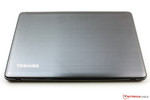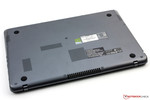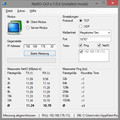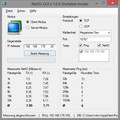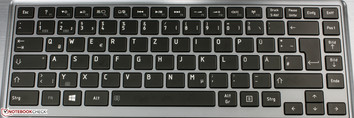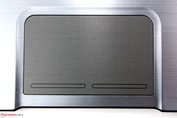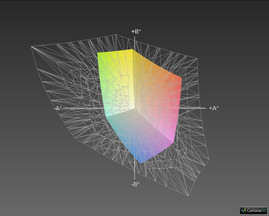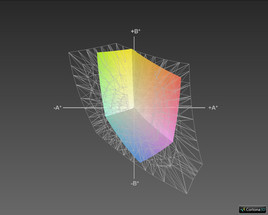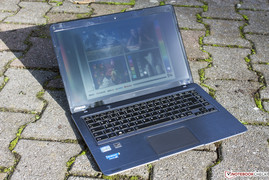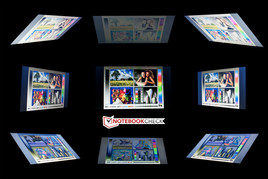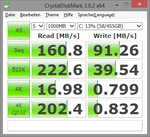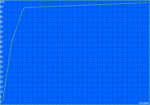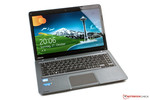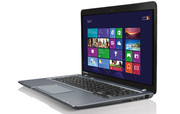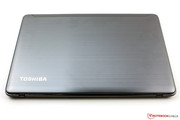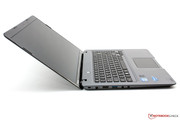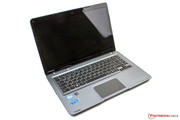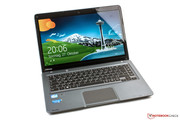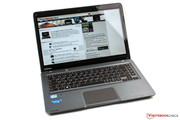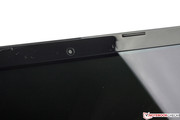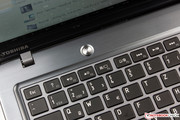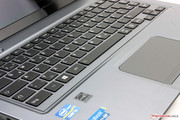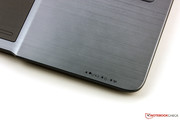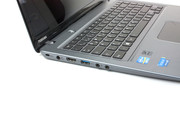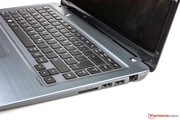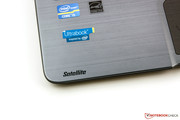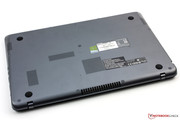Review Toshiba Satellite U840T-101 Ultrabook

For the original German review, see here.
With the Satellite U840T-101, Toshiba released an ultrabook into the mix that was already technically overmatched by its release date. Just a month later, Intel's Haswell generation is supposed to begin its run. Still, the Japanese firm presents a thoroughly attractive package that has, meanwhile, steeply declined in price and can be had for just 799 Euros (~$1080). Just as before, the Intel Core i5-3337U offers a good and economical performance level. 8 GB of RAM and the Intel HD Graphics 4000 integrated graphics system support it. Apart from the ample 500 GB hard drive, the manufacturers have sprung for an additional 32 GB Caching SSD. There are several variously equipped versions in this series:
| Model | U840t-101 | U840t-103 | U840t-109 | U840t-10C |
|---|---|---|---|---|
| Processor | Intel Core i5-3337U | Intel Core i5-3337U | Intel Core i3-3217U | Intel Core i5-3337U |
| RAM | 8 GB | 8 GB | 6 GB | 6 GB |
| Hard Drive | 500 GB | none | 500 GB | none |
| Solid State Drive | 32 GB (Caching) | 128 GB | none | 256 GB |
Still, the competition has not been sleeping, and they offer similarly equipped ultrabooks in the race for market share. The HP Envy TouchSmart 4-1102sg even comes from last year, though the processor (i5-3317U, 1.7 GHz) is somewhat weaker. On the other side, the U840T has to prove itself against current Haswell ultrabooks, such as the Lenovo IdeaPad U430 Touch (i5-4200U, 1.6 GHz), which even offers an additional dedicated graphics card.
The Toshiba Satellite U840T-101 is slim, as befits a true ultrabook. The manufacturer measures the machine's height at 20.7 mm, which is just under the prerequisite height of 21 mm, which determines whether the notebook can call itself an ultrabook. At 1,736 grams (~3.8 pounds) the U840T's weight is appropriate to its class.
The upper surfaces are kept in an aluminum design, which has a palpably pleasing, well-made effect. Also, fingerprints are not visible too quickly. The slim display is encased in a high-luster plastic frame, which seems to magically attract dust. The panel can be twisted quite easily, but it does not creak or crack; on the contrary, it seems quite stable. The base unit, on the other hand, proves itself quite stiff and leaves a solid impression. The clearances are even and offer no grounds for criticism.
Both display hinges keep the touch screen reliably in position. Still, the panel swings back and forth a bit when the base is shaken. We appreciate the fact that the ultrabook discharges its heat to the rear. The battery is fixed in place and cannot be swapped out without serious effort. Despite this, the product leaves behind a good impression in terms of workmanship.
The connectivity is at the usual level for an ultrabook. The available USB 3.0 port can be used even when the machine is shut down to provide power to external devices. This must, however, be activated beforehand in BIOS. The integrated card reader supports cards in the SD format up to 64 GB (SDXC) as well as MMC cards up to 2 GB.
Fortunately, the ports are all positioned far to the back and thereby do not interfere with the external input devices, even when all of them are occupied.
Communications
The Toshiba Satellite U840T-101 has a Fast Ethernet connection at its disposal, which allows the machine to connect over LAN. Unfortunately, Gigabit LAN is not provided, as it is in rival machines. With the NetIO tool, we tested the components' data transfer rate and availed ourselves of an individual test arrangement. As a remote station, we used a normal desktop PC; the data were transferred over a gigabit switch. The LAN interface of the U840T worked very quickly given its proportions; here there is nothing to criticize.
Alternatively, the ultrabook can also connect over WLAN. The built-in Intel Centrino Wireless-N 2230 module supports the IEEE-802.11 standards b/g/n and transmits only in the bandwidth of 2.4 GHz. The maximum transfer rate is also limited to 150 MBit/s, and in practice we only achieved half this rate. For all that, the range of the WLAN is quite good. Even at a distance of 20 m (~66 feet) from the router (Fritz!Box 6360), we still had a good signal strength and could not notice any impairments while surfing the web.
Accessories
The accessories are quite spartan; they include, apart from a power cord with a nominal capacity of 45 W (19 V, 2.37 A) just a how-to and a warranty booklet.
Those who had expected Windows 8 on a data storage device, or at least a DVD with drivers, will be disappointed. Instead, the Japanese firm offers the option to create a recovery data storage device with the preinstalled tool Recovery Media Creator. We recommend this strongly. The machine has a Recovery Partition at its disposal anyway; if the hard drive fails or is swapped out, this will be good for nothing.
Toshiba offers no custom-built accessories directly on the Satellite U840T, but it offers sufficient universal notebook accessories.
Maintenance
The ultrabook's maintenance options are severely constrained and not even supported by Toshiba. Those who wish to remove the bottom panel must not only prize free a few screws. The casing is also held in place by two further screws that are only accessible by removing the keyboard. Since this is a loaned machine, we decided to forgo this procedure.
Apart from that, Toshiba indicates that the RAM modules should only be expanded by authorized staff. Even cleaning the fan or switching out the battery is impossible for the user.
Warranty
Toshiba grants a 12-month warranty on its ultrabook, which can be extended directly from the manufacturer. The Japanese firm offers various international warranty extensions in its shop, between two and four years (34 to 109 Euros, or ~$45-150). In case of damage, the machine must be sent to Toshiba.
The so-called "Whatever-happens warranty" can be had for one (59 Euros, ~$80) or three (74 Euros, ~$100) years. It includes accident and theft protection as well as a data retrieval service apart from the usual warranty conditions.
Toshiba offers an in-store service (99 to 119 Euros, ~$135-160) as well, which is available in Europe, the Middle East, and Africa (at a range of 100 km/~62 miles around major cities).
Purchasers in Austria and Germany can enjoy a two-year merchants' warranty.
Update to Windows 8.1
Windows 8 (64-bit) is installed as an operating system and can be updated to the current Version 8.1 for free. To do this, users must simply open Windows Store, where the update is offered for installation as an app.
Downloading and installing the update requires a fair bit of time. Still, those who have already installed all updates that Windows provides will have no problems after the changeover. It is important that the update be executed with the desktop version, so that optional updates can also be installed. For this purpose, Toshiba has provided three new drivers.
There are no huge performance improvements here. Despite that, the system achieves somewhat better results in PCMark 8 Work, as well as in 3DMark. Apart from that, the HD 4000 receives a new driver (Version 10.18.10.3308). We definitely recommend this update for its improved user friendliness.
Keyboard
The keyboard's dimensions are comfortable. The QWERTY keys are fairly wide, at 15 x 12 mm, but not especially deep. The average stroke is very weak and sponge-like. Unfortunately, the keys do not give clear feedback. Despite that, we could hear a decent click. The input surfaces are flat and built completely out of smooth plastic. Under strong pressure, the middle of the keyboard sinks noticeably. The one-level backlighting is white and comfortably consistent. Overall, the input device leaves a mixed impression but does not really convince us.
Touchpad
The touchpad measures at 100 x 62 mm (~3.9 x 2.4 inches) and has two integrated mouse buttons at its disposal. These are quite stiff, but they give clear feedback when their resistance is overcome. The swipe features of the pad are decent and reflect their inputs precisely, but they could stand to be quicker. For the moment, this input device suffices. However, those who really want to work with the machine are hamstrung without the addition of a mouse.
Touchscreen
The 14-inch capacitive touchscreen recognizes up to ten contacts at the same time. Inputs are immediately implemented. Unfortunately, the swipability of the surface is not good. It feels like our fingers remain glued to the screen when we try to move them.
The 14-inch display comes from the AU Optronics house and has a resolution of 1366x768 pixels. This corresponds to its ratio of 16:9 and a pixel density of 112 ppi. In view of the panel's diagonal, a higher resolution would have been desirable, since (for example) even the description tests in the Windows Store present a rough-around-the-edges effect.
The panel has a glossy upper surface and a brightness of just 177 cd/m², which is not particularly bright. With indoor use, this will cause no problems, but the value is still below average. At 79%, the illumination is also not particularly good, which again is not noticeable in everyday use.
| |||||||||||||||||||||||||
Brightness Distribution: 79 %
Center on Battery: 189 cd/m²
Contrast: 859:1 (Black: 0.22 cd/m²)
ΔE ColorChecker Calman: 9.18 | ∀{0.5-29.43 Ø4.78}
ΔE Greyscale Calman: 9.84 | ∀{0.09-98 Ø5}
35.89% AdobeRGB 1998 (Argyll 1.6.3 3D)
39.49% AdobeRGB 1998 (Argyll 3D)
56.8% sRGB (Argyll 3D)
38.15% Display P3 (Argyll 3D)
Gamma: 2.63
CCT: 11873 K
The black level, at 0.22 cd/m², is quite good and offers no technical grounds for criticism. The high contrast of 859:1 is excellent.
Unfortunately, the color calibration is unconvincing. The grayscale shows a noticeable deviation, with an average DeltaE of 10. Likewise, we noticed a clear blue tint, which leaves the image content appearing quite cool. This is confirmed by the otherwise moderately calibrated color saturation, by which blue is a noticeable outlier (DeltaE 20). The color mask (sRGB: 51%, Adobe RGB: 36%) also makes it clear that professional image editing or presenting is out of the question.
Outdoors, the Toshiba Satellite U840T-101 can be used despite the weak light power of its displays, as long as it does not get too bright. Indeed, in the shade, it offers a decent image and it can be used without restrictions. However, in direct sunlight the reflections are the lesser evil, since the panel is just not luminous enough.
The viewing angle stability of the ultrabook is below average, even for a TN panel. With each change in our sitting position, we had to adjust the display in order not to see any color changes or inversions. Even nodding the head can lead to misrepresentations on the screen. For that reason, despite its high contrast and good black level, there is little to enjoy in the Satellite U480T's multimedia use.
The Toshiba Satellite U840T-101's performance base is the Intel Core i5-3337U, which comes from the Ivy Bridge generation and is supported by the integrated Intel HD Graphics 4000 graphics system. 8 GB of RAM lends its support, operating in dual channel mode. The conventional hard drive offers lots of space and is supported by an additional SSD.
Processor
The Intel Core i5-3337U does duty as the Satellite U840T-101's processor. The dual-core has a base speed of 1.8 GHz that can be increased to up to 2.7 GHz (single-core) with the help of Turbo Boost 2.0. Thanks to Hyperthreading, up to four threads can be worked on at once. The thrifty ULV processor has a TDP of 17 W, in which light the integrated HD 4000 seems well considered.
The CPU's performance is absolutely on target. In the Cinebench R11.5 benchmarks, the test machine achieves 1.11 points in the single-core test and 2.52 in the multi-core test. The Turbo is fully used at all times, which is even the case in battery use, to our delight. The Lenovo U430 (i5-4200U, 1.6 - 2.6 GHz) is no faster (despite being from a newer processor generation) and actually cycles more slowly.
System Performance
The U840T-101's system performance is quite decent and is nothing to sneeze at in comparison with machines at the same performance level. In the PCMark 7 test, the test machine achieves a solid 4,300 points but must admit defeat to the HP Envy TouchSmart 4-1102sg (4,460 points), which has a Caching SSD at its disposal. Only the Gigabyte S1185 (4,393 points) is likewise just a bit faster; it relies completely on a Flash drive. These always perform well in the PCMark test.
Subjectively, there is nothing to complain about. For a configuration based primarily on a HDD as its drive, the U840T is quite zippy.
| PCMark 7 - Score (sort by value) | |
| Toshiba Satellite U840T-101 | |
| Samsung ATIV 540U4E-K01US | |
| Wortmann Terra Mobile Pad 1160 Pro | |
| Lenovo IdeaPad U430 Touch 59372369 | |
| Gigabyte S1185 | |
| HP Envy TouchSmart 4-1102sg | |
| PCMark Vantage Result | 5877 points | |
| PCMark 7 Score | 4300 points | |
| PCMark 8 Home Score Accelerated | 2799 points | |
| PCMark 8 Creative Score Accelerated | 2316 points | |
| PCMark 8 Work Score Accelerated | 4580 points | |
Help | ||
Storage Devices
A traditional hard drive (HDD) of in-house production is used as the primary storage device, rotating at 5,400 rpm and storing 500 GB of data. At the start, only about 417 GB are available, the rest being taken up by recovery partitions and the preinstalled operating system. The Caching SDD from Samsung is also built in with 32 GB, which cannot be employed as a drive by the user. Instead, it should allow the system to start faster and permit a faster wake-up from sleep. Apart from this, the drive is adaptive and speeds up the most often used programs, increasing its read speed.
In sequential reading of data, the combination proves itself fairly quick. The reading of small data blocks is also at a good level, thanks to the Caching SSD. However, this system does not touch the performance of a full-fledged Solid State Drive such as the one in the S1185.
Graphics card
The integrated Intel HD Graphics 4000 is responsible for graphics rendering. It possesses RAM storage and runs in the Satellite U840T-101 between 350 and 1,100 MHz. It offers enough performance for everyday assignments and supports video coding.
Compared to other systems, the GPU used here is somewhat faster. In the 3DMark Fire Strike test, it achieves 581 points, higher than other models with the same GPU. The Lenovo U430 (GeForce GT 730M, 920 points), which has a dedicated GPU, is markedly faster.
| 3DMark 11 | |
| 1280x720 Performance (sort by value) | |
| Toshiba Satellite U840T-101 | |
| Gigabyte S1185 | |
| HP Envy TouchSmart 4-1102sg | |
| 1280x720 Performance GPU (sort by value) | |
| Toshiba Satellite U840T-101 | |
| Gigabyte S1185 | |
| HP Envy TouchSmart 4-1102sg | |
| 3DMark | |
| 1920x1080 Fire Strike Score (sort by value) | |
| Toshiba Satellite U840T-101 | |
| Gigabyte S1185 | |
| Wortmann Terra Mobile Pad 1160 Pro | |
| Lenovo IdeaPad U430 Touch 59372369 | |
| 1920x1080 Fire Strike Graphics (sort by value) | |
| Toshiba Satellite U840T-101 | |
| Gigabyte S1185 | |
| Wortmann Terra Mobile Pad 1160 Pro | |
| Lenovo IdeaPad U430 Touch 59372369 | |
| 3DMark 05 Standard | 9176 points | |
| 3DMark 06 Standard Score | 6057 points | |
| 3DMark Vantage P Result | 3665 points | |
| 3DMark 11 Performance | 683 points | |
| 3DMark Ice Storm Standard Score | 39817 points | |
| 3DMark Cloud Gate Standard Score | 3983 points | |
| 3DMark Fire Strike Score | 581 points | |
| 3DMark Fire Strike Extreme Score | 293 points | |
Help | ||
Gaming Performance
Games from the Windows Store present no problem for the U840T-101. It looks different with current 3D titles. Games with elaborate textures are simply too much of a good thing and are playable (in the best case) only with reduced resolution and minimal details.
| low | med. | high | ultra | |
|---|---|---|---|---|
| BioShock Infinite (2013) | 32.5 | 17.4 | 15.3 | |
| Total War: Rome II (2013) | 29.9 | 21.6 | ||
| F1 2013 (2013) | 34 | 28 | 24 |
System Noise
The noise development of the ultrabook is moderate. In idle use, the measured sound pressure lies between 30.4 and 32 dB(A). Still, we could always hear the hard drive clattering away. During longer copying processes, the HDD adds its own bothersome ticking noise.
Under load, the levels increase to up to 41.9 dB(A) and become clearly audible. The fan rotates very frequently, so that this noise becomes distracting after a while. Still, this level of noise is seldom heard in everyday use; we reached it only with full use of both CPU and GPU.
Noise level
| Idle |
| 30.4 / 30.4 / 32 dB(A) |
| HDD |
| 31.2 dB(A) |
| Load |
| 36 / 41.9 dB(A) |
 | ||
30 dB silent 40 dB(A) audible 50 dB(A) loud |
||
min: | ||
Temperature
The surface temperatures of the Toshiba Satellite U840T-101 are warm to the touch, even in idle use, and reach a height of 37.4 °C (99.32 °F). In comparison, the HP Envy stays the coolest (max. 34.1 °C/93.38 °F).
Under full load, which we simulated with the simultaneous use of Prime95 and FurMark, the temperatures rise to a striking maximum value of 54.1 °C (129.38 °F) on the underside in the area of the fan outlet. In such a situation, use on the lap becomes extremely uncomfortable. On the upper side, the measurements above the keyboard rise to up to 53.2 °C (127.76 °F). Those who set their hands there, in order to use the touch screen, will not leave them there for long. Still, it should be noted that this presents an extreme scenario that is seldom achieved in practice.
In our stress test, the cycling performance of the processor and graphics system will be illuminated. Here we also used Prime95 and FurMark simultaneously and let the system run under this load for at least an hour. The CPU throttles back fairly quickly and falls back to the base speed of 1.8 GHz, and the GPU offers only 900 MHz. Still, we could not detect a severe throttling. The subsequent 3DMark 06 test (5,918 points) reached just slightly under the values (6,057 points) which were achieved in cold conditions.
(-) The maximum temperature on the upper side is 53.2 °C / 128 F, compared to the average of 34.3 °C / 94 F, ranging from 21.2 to 62.5 °C for the class Office.
(-) The bottom heats up to a maximum of 54.2 °C / 130 F, compared to the average of 36.8 °C / 98 F
(+) In idle usage, the average temperature for the upper side is 28.1 °C / 83 F, compared to the device average of 29.5 °C / 85 F.
(+) The palmrests and touchpad are cooler than skin temperature with a maximum of 27.6 °C / 81.7 F and are therefore cool to the touch.
(±) The average temperature of the palmrest area of similar devices was 27.6 °C / 81.7 F (0 °C / 0 F).
Speakers
Both stereo speakers are enhanced by SRS Premium Sound 3D and can be quite loud. The midrange is almost unavailable and the bass is quite thin but audible. Unfortunately, the highs are somewhat muffled, which sounds especially bad at a high volume. The equalizer has some effect, but we still could not hear a clear tone.
For occasional sound output, the built-in system is certainly sufficient, but for multimedia usage, there can be no question. The audio jack works flawlessly.
Power Consumption
The Satellite U840T-101's power consumption lies between 6.5 and 10.8 Watts in idle use, eye to eye with that of the Haswell competitor IdeaPad U430 Touch (6.7–10.6 W) and markedly under that of Envy TouchSmart (7.3–16.4 W).
Under load, the usage values climb to up to 42.5 W. Despite the markedly stronger graphics system, the Lenovo U430 requires just three Watts more. While turned off (0.2 W) and on standby mode (0.3 W), the measurements of our test product are slightly high, but still within an acceptable range. The power cord is a bit lean with a nominal capacity of 45 W, even if its dimensions are adequate.
| Off / Standby | |
| Idle | |
| Load |
|
Key:
min: | |
Battery Life
The Toshiba Satellite U840T-101's energy storage reaches 52 Wh. With minimal panel brightness and deactivated communications modules, the ultrabook achieves a maximum run time of seven solid hours in the Battery Eater Reader’s Test. In the opposite scenario, with maximum display brightness and all power consumers activated, we ascertained the minimum run time. We made use of the Battery Eater Classic Test in order to drain the battery as quickly as possible, which we managed in 2 hours, 43 minutes.
The "surfing over WLAN" test is nearer to practical usage requirements. With an appropriate panel brightness of 150 cd/m², a new website is loaded every 40 seconds using a browser script. Here the test product holds out for just about four hours, running for a markedly shorter time than the competitors from Lenovo (5 hours, 29 minutes) and HP (5 hours, 45 minutes).
The battery requires a long time to fully charge. A charge of 95% took 3.5 hours to reach. In order to fill the extra five percent, we had to wait 21 additional hours. This should actually be scored positively, since it protects the chemical composition of the battery and increases its lifespan.
The Toshiba Satellite U840T-101 is a high-performance ultrabook with tidy workmanship. The fact that it does not employ Intel's current processor generation is no detriment to its performance. The built-in Core i5-3337U achieves the same values as the newer i5-4200U in synthetic benchmarks. The test product only loses a feather from its cap in graphics performance, but with an HD 4000, it is still well equipped compared to other machines.
Toshiba's ultrabook would not actually be that bad a machine, except that the display is comparatively dark and the viewing angle stability seldom allows for flawless viewing. Moreover, the fact that the Japanese firm decided not to spring for a Gigabit LAN port does not exactly recommend it either.
Those who like to watch a film or work with graphics while on the run should steer clear of this notebook. But if communication features and office use are the main considerations, the U840T can still be the right choice.





